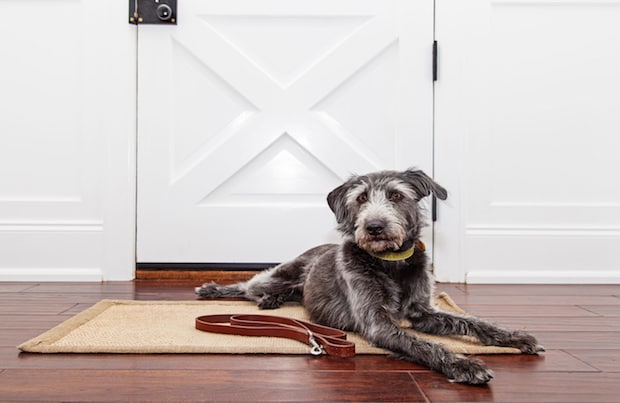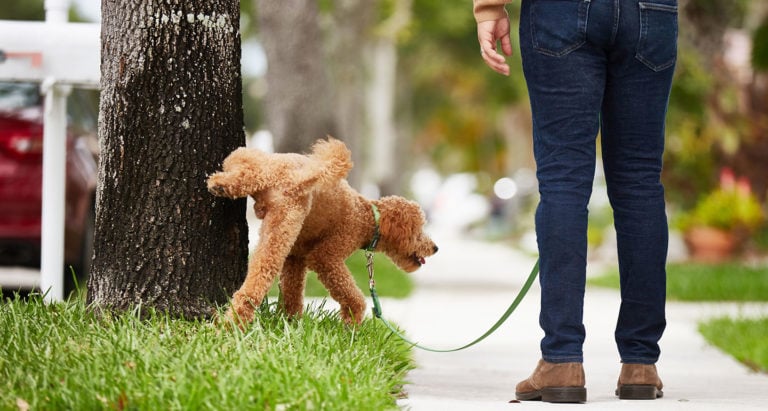Does your dog dart out the door when you open it? Sure, it’s a pushy behavior when your pup is on a leash and heading out with you for a walk, but it’s a downright dangerous one when he dashes out the door, sans leash. Putting a stop to this behavior takes time and attention, but ensuring your dog’s safety is well worth the effort.
Step One: Make a Plan
The first option for any training challenge is to manage the situation so that the negative behavior can’t take place. For example, if your dog barks at the pizza delivery person you can manage their behavior by putting him in a different room when dinner shows up. Similarly, by using the right management tools, like baby gates or a leash/tether, you should be able to prevent your dog from escaping when you open the door. Emphasis on the word ‘should,’ though: management isn’t failsafe.
If you live in a typically busy household with a variety of people coming and going there’s a good chance that someone might not put the plan into action. They might forget to put a leash on Fido, or lean the baby gate in such a way that one good nose bump sends it tumbling down. That said, a management plan is better than no plan at all to keep your dog safe, and it’s a great second line of defense as you work through a hands-on training program.
Then, Start a Training Program
The secret to training success for a door dasher is breaking down the process into manageable steps. First, bring your dog to a frequently used door and get him to sit a few feet away from it. Say “wait” once, take several steps away from your dog then come back quickly and reward him with a very high value treat. If your dog has experience with “stay” this should feel familiar to him.
The introductory phase near the door can be challenging, though, as most dogs understand that the door means freedom, walks, visitors and other goodies. Don’t be surprised if your dog is fidgety. You might only be able to take a baby-step away the first few times you try it. Ask your dog to sit and wait several times, making sure to walk away from your dog in different directions so that your movement towards the door looks realistic and not predictable. Practice at a variety of different doors in your home —sliding doors, the door to the garage — until your dog can wait as you walk away from him towards any door in your home.
Practice Makes Perfect
Once your dog is able to remain seated when you tell him to “wait” and step away from him toward the door, it’s time to make the process more challenging. Ask him to sit-and-wait, walk to the door and put your hand on the knob, but don’t open the door. If your dog starts to get up take your hand off the knob, go back to him and ask him to sit and wait again. If your dog remains still while your hand is on the knob, open the door a tiny bit, then close it again, go back to your dog and reward him with a treat. Work on opening the door in successive increments, opening it slightly wider each time, then close it and return to your dog to give him a treat. Continue this process until you can open the door all the way and your dog doesn’t move. It’s also a good idea to put your dog on a leash and tether him to a heavy piece of furniture, or have a helper hold the leash when you get to this step.
Practice the behavior often in scenarios that mimic real life. Keep in mind that door dashing can occur in a variety of circumstances, like when someone is coming in to your house as well as when you’re leaving. Practice with your dog so that he can the “wait” when you’re going through the door and leaving him behind. It helps to give your dog some sort of “all done” signal as you go through the door, so that you’re the one releasing him rather than him deciding that he’s done. This helps to drive home the point that you control his door access. Pick a word like “free” and say it as you’re out the door and closing it, then toss the treat down the hall so that your dog has to run after it to get it.
You should use the wait/free cues every time you go through the door with your dog to keep them fluent. When you take your dog out for a leash walk put him in a sit/wait a few feet away from the door, then walk to the door, open it all the way, pause and then say “free” and allow your dog to go through the door with you. You can reward your dog with a treat for holding the “wait,” but for most dogs the excitement of being outside is reward enough! Use the same sit/wait process if you let your dog out to your fenced back yard. Asking for a wait and then releasing him is a wonderful way to instill some impulse control in an exciting scenario.
The Must-Have Cue
Sometimes dogs forget their manners, particularly when it comes to activity near the door, so it helps to train an emergency “come inside now” cue for those occasional scenarios. It’s similar to a recall, but it should only be used to get your dog back in the house, not to get him to come to you at the dog park.
Go through the typical “sit/wait/release” process with your dog while he’s on leash, then right as you cross the threshold to go outside with him step back inside and make a happy-kissy noise to get him to follow you back in. The moment he crosses the threshold to get to you say “home” and give him a wonderful treat. With enough repetitions the word “home” will mean “come to me in the house to get an amazing goody” You can test your dog’s responsiveness to this cue by putting him on an extra-long dog leash (so he has more freedom than on his regular leash), releasing him out the door, and then saying “home!” If you’ve practiced enough and used a really excellent treat, your dog should turn around and come racing back in the house!

Victoria Schade is a dog trainer, author & speaker who has contributed to The Washington Post, Martha Stewart, and other publications.
Share:









